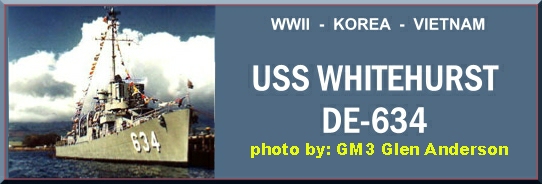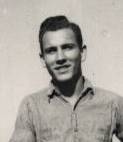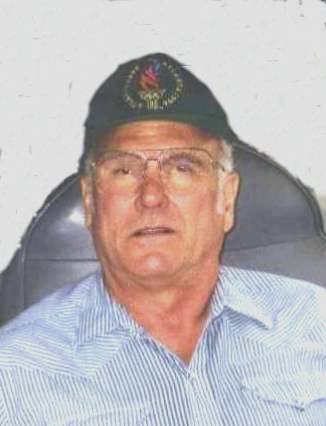
Logo by: Pat Stephens, Webmaster, DESA
|
Dead in the Water off Cape Hatteras |
|
|
|
|
|
Shortly after the "Korean Conflict" started, 25 June 1950, Whitehurst was Recommissioned for duty as a power ship in Korea. The ship was taken from Green Cove Springs Florida, to Charleston, SC for some refitting before heading south for the Panama Canal then to San Diego, Pearl Harbor, then on to Korea. Shortly after entering the vicinity of Cape Hatteras, which has some of the roughest seas anywhere, the ship lost steam pressure from both boilers. Without boiler pressure, the turbines, generators, propellers, and even the oil pumps quickly stop. The only light below decks is the emergency lights from battery powered lanterns. Above decks was the darkness of the sea at midnight. mc contributor: Al Crawford QM1 in 1950 What I remember the most of the
incident of Cape Hatteras was lying in my bunk and trying to get some sleep.
Without power we were unable to keep the bow of the ship into the wind, and lost
steering control and slipped into a trough. I have no way of knowing how
far the ship rolled to port, then to starboard, and back and forth again, and
again.
|
|
Hugh Toney's Memory of the Incident |
|
|
|
I was trying to stay in bunk, so seasick I almost wanted to die. BTC Kloever came in and said "Get the hell out of the rack Toney and lend a hand on the auxiliary oil pump in Boiler Room #2. I struggled in my clothes and followed him into the midships passage way where some other seasick guys were lying on the deck in the after head. The excessive rolling had caused water to pour out of the old trough toilets and was sloshing back and forth over the seasick sailors. Chief Kloever caught a sailor who was headed aft in the passage way and told him, "Get some help and drag these guys below before they drown." I went into the darkness in the #2
Boiler Room to man the auxiliary oil pump. It is a crank device operated
by one man. The objective is to pump oil to the burners manually until the
boilers produce enough steam to power the turbines, main oil pump, generators
and the motors which drive the propeller shafts. Initially men with
torches are waiting to light the oil that is manually pumped to the
boilers. The same process takes place in both boiler rooms. The
Auxiliary Pump is operated by one man until he must turn the job over to a man
who is less exhausted. Imagine doing this on the rolling, pitching deck,
in a dark, hot, sweaty, foul smelling boiler room. It is no fun and even
less so when weakened by sea sickness. |
|
Jack Nettles Account |
|
|
|
Jack Nettles 2003 |
| When the Whitehurst was put back in commission
on 9-1-50, there was only a couple of regular boiler tenders on board. Most were
reserves. On September 23, 1950 I and 12 other firemen apprentices, fresh out of boot camp, came aboard.
Eight of us went into the boiler room,
the other four into the engine room. You can see there was little knowledge
on board that knew about the boilers on the Whitehurst. After a couple of days
of checking out the power system we would go to sea on our way to Norfolk but
would break down and have to be towed back in. This happened twice. On the
third try we were off cape Hatteras when we hit
bad weather and things happened. I had the 8 to 12 watch and I was so
sick I thought I'd die. I was relieved at 11:45 and we still had power at that time, so
what caused the fires to go out, I have no idea. While on my way to my bunk I
was so sick that a draft of cool air just aft of the the after head felt
so good that I just laid down on the deck.
Later some mates came along and carried me to my rack, which was in 2nd
division compartment, top bunk right under # 3, 3 inch gun mount, When we
lost power and the ship started to roll the horizontal control gearing on
the gun mount broke loose, allowing the gun barrel to swing around from
stop to stop, and it did make some noise! We had a good amount of damage aboard when day light came.
The gun barrel had to be replaced.
We didn't make it to Norfolk under our own
steam. A tug was sent out to tow us in. I turned 17 on October 14 while
in Norfolk. To the best of my knowledge this is the way it was in 1950, many
years ago.
|
|
Memories of Ens Dave Harlan, Communications Officer 1950 & '51 The Whitehurst was headed for Norfolk for inspection before she headed to the Pacific. At the time my bunk was in the after officers quarters, and I was trying to sleep. All I remember is that a large sewing machine in the adjacent compartment broke loose and was rolling back and forth with each roll of the ship. It was loud as a cannon, and to heavy to secure. The ship got steam pressure at about 0600, and we headed back to
Charleston for repairs. We did make it to Norfolk, under our own power,
several days later. |
WWII Era | Korea War & '50s | Viet Nam & 60s | Reunions | All Links Page Search & Rescue
Memorial | Poetry | Enemy Below | Taps List | Photos/Armament | History | Crews Index | Home



